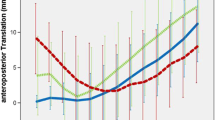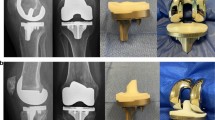Abstract
Purpose
The purpose of this study was to compare in vivo kinematics, range of motion, and functional outcomes in patients that received either a high-flexion cruciate retaining or a high-flexion cruciate substituting knee.
Methods
Forty-eight high-flexion cruciate retaining (CR) and 47 high-flexion cruciate substituting (PS) knees were included in this study and followed for an average of 27 months (24–33). Weight-bearing and non-weight-bearing maximal flexions and functional scores were compared between two groups. For kinematics evaluations, amount of posterior femoral roll-back and internal tibial rotation from 0° to maximal flexion using lateral radiographs under weight-bearing conditions were also compared.
Results
Average weight-bearing maximal flexion was 126.3° in the PS group, which was significantly higher than the 115.0° in the CR group. Average functional scores showed no significant difference between the two groups. In terms of kinematics, the average amount of posterior femoral roll-back during full flexion was 9.6 mm in the PS group and 6.1 mm in the CR group, which was a significant difference. However, internal tibial rotation during full flexion was not significantly different in the two groups.
Conclusion
PS high-flexion TKA provided greater weight-bearing maximal flexion and posterior femoral roll-back than CR high-flexion TKA, although no difference in clinical outcomes was observed between the two prosthesis designs.
Level of evidence
I.




Similar content being viewed by others
References
Anouchi YS, McShane M, Kelly F Jr et al (1996) Range of motion in total knee replacement. Clin Orthop Relat Res 331:87–92
Banks SA, Markovich GD, Hodge WA (1997) In vivo kinematics of cruciate-retaining and -substituting knee arthroplasties. J Arthroplasty 12:297–304
Becker MW, Insall JN, Faris PM (1991) Bilateral total knee arthroplasty. One cruciate retaining and one cruciate substituting. Clin Orthop Relat Res 271:122–124
Bellemans J, Banks S, Victor J et al (2002) Fluoroscopic analysis of the kinematics of deep flexion in total knee arthroplasty. Influence of posterior condylar offset. J Bone Joint Surg Br 84:50–53
Cates HE, Komistek RD, Mahfouz MR et al (2008) In vivo comparison of knee kinematics for subjects having either a posterior stabilized or cruciate retaining high-flexion total knee arthroplasty. J Arthroplasty 23:1057–1067
Dennis DA, Komistek RD, Colwell CE Jr et al (1998) In vivo anteroposterior femorotibial translation: a multicenter analysis. Clin Orthop Relat Res 356:47–57
Dennis DA, Komistek RD, Mahfouz MR et al (2003) Multicenter determination of in vivo kinematics after total knee arthroplasty. Clin Orthop Relat Res 416:37–57
Dennis DA, Komistek RD, Mahfouz MR et al (2004) A multicenter analysis of axial femorotibial rotation after total knee arthroplasty. Clin Orthop Relat Res 428:180–189
Dennis DA, Komistek RD, Stiehl JB et al (1998) Range of motion following total knee arthroplasty: the effect of implant design and weight-bearing conditions. J Arthroplasty 13:748–752
Hartford JM, Banit D, Hall K et al (2001) Radiographic analysis of low contact stress meniscal bearing total knee replacements. J Bone Joint Surg Am 83:229–234
Kim YH, Choi Y, Kwon OR et al (2009) Functional outcome and range of motion of high-flexion posterior cruciate-retaining and high-flexion posterior cruciate-substituting total knee prostheses. A prospective, randomized study. J Bone Joint Surg Am 91:753–760
Kim YH, Sohn KS, Kim JS (2005) Range of motion of standard and high-flexion posterior stabilized total knee prostheses. A prospective, randomized study. J Bone Joint Surg Am 87:1470–1475
Landis JR, Koch GG (1977) The measurement of observer agreement for categorical data. Biometrics 33:159–174
Maloney WJ, Schurman DJ (1992) The effects of implant design on range of motion after total knee arthroplasty. Total condylar versus posterior stabilized total condylar designs. Clin Orthop Relat Res 278:147–152
Massin P, Gournay A (2006) Optimization of the posterior condylar offset, tibial slope, and condylar roll-back in total knee arthroplasty. J Arthroplasty 21:889–896
Most E, Sultan PG, Park SE et al (2006) Tibiofemoral contact behavior is improved in high-flexion cruciate retaining TKA. Clin Orthop Relat Res 452:59–64
Most E, Sultan PG, Park SE et al (2005) Kinematic analysis of conventional and high-flexion cruciate-retaining total knee arthroplasties: an in vitro investigation. J Arthroplasty 20:529–535
Myles CM, Rowe PJ, Walker CR et al (2002) Knee joint functional range of movement prior to and following total knee arthroplasty measured using flexible electrogoniometry. Gait Posture 16:46–54
Sharma A, Komistek RD, Scuderi GR et al (2007) High-flexion TKA designs: what are their in vivo contact mechanics? Clin Orthop Relat Res 464:117–126
Shi K, Hayashida K, Umeda N et al (2007) Kinematic comparison between mobile-bearing and fixed-bearing inserts in Nexgen legacy posterior stabilized flex total knee arthroplasty. J Arthroplasty 23:164–169
Stiehl JB, Komistek RD, Dennis DA (1999) Detrimental kinematics of a flat on flat total condylar knee arthroplasty. Clin Orthop Relat Res 365:139–148
Stiehl JB, Komistek RD, Dennis DA et al (1995) Fluoroscopic analysis after posterior cruciate retaining knee arthroplasty. J Bone Joint Surg Br 77:884–889
Suggs JF, Hanson GR, Park SE et al (2008) Patient function after a posterior stabilizing total knee arthroplasty: cam-post engagement and knee kinematics. Knee Surg Sports Traumatol Arthrosc 16:290–296
Suggs JF, Kwon YM, Durbhakula SM et al (2009) In vivo flexion and kinematics of the knee after TKA: comparison of a conventional and a high flexion cruciate-retaining TKA design. Knee Surg Sports Traumatol Arthrosc 17:150–156
Acknowledgments
No benefits in any form have been received or will be received from a commercial party related directly or indirectly to the subject of this article.
Author information
Authors and Affiliations
Corresponding author
Rights and permissions
About this article
Cite this article
Seon, JK., Park, JK., Shin, YJ. et al. Comparisons of kinematics and range of motion in high-flexion total knee arthroplasty: cruciate retaining vs. substituting designs. Knee Surg Sports Traumatol Arthrosc 19, 2016–2022 (2011). https://doi.org/10.1007/s00167-011-1434-z
Received:
Accepted:
Published:
Issue Date:
DOI: https://doi.org/10.1007/s00167-011-1434-z




